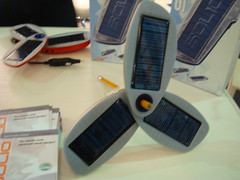
Back in 2006, Tim Locke and Engadget spotted a new recorder from Edirol. We were disappointed in earlier models which had rather insensitive microphone inputs leading to far too much hiss.
David Zantow in Wisconsin tells me Roland, who make Edirol, have just updated the R-09 digital recorder to the new R-09HR model. It was shown a few days ago at an audio show in Frankfurt, Germany. It now includes a wireless remote control and reports tell us that they have addressed the hiss and shielding issues that plagued the original R-09.
The new specs says
- 24-bit/96kHz linear PCM high-resolution, low-noise recording
- Newly developed Isolated Adaptive Recording Circuit (I.A.R.C.)
- High-grade, high-sensitivity stereo condenser microphone built-in
- Records to SD or SDHC memory card (Up to 8 GB)
- Compact, hand-held body for convenient portable use
- Wide view-ability on large OLED (Organic Light-Emitting Diode) display
- Preview speaker built-in
- Wireless remote controller included
- High-speed file transfer via USB 2.0 connection to computer
- Cakewalk "pyro Audio Creator LE" wave-editing software included
Small enough to fit in a shirt pocket, the R-09HR has a new tactile feel that is easy to grip. It also has a user-friendly OLED (Organic Light-Emitting Diode) graphic display for easy operation. The large display provides a wide view with easy-to-see level meters, peak indicators, and additional recording information onscreen. A built-in preview speaker allows instant playback of the recorded sounds —no headphones required. With the included wireless remote controller, transport functions can be accessed from a distance. Style wise, you either love it or hate it.
The R-09HR can connect to computers via USB for importing/exporting audio files. It supports Hi-Speed USB (USB 2.0) mass storage so file transfers are quick and convenient. Included with the R-09HR is Cakewalk's pyro Audio Creator LE software —a perfect companion for WAV/MP3 audio file editing. With pyro, the R-09HR package becomes a complete recording solution suite, from recording to CD-burning.
A wide variety of optional accessories are available for the R-09HR, including: Cover/Stand Set (OP-R09HR-C), Silicone Rubber Case (OP-R09HR-S), Carrying Pouch (OP-R09HR-P), Microphone Stand Adaptor (OP-R09M), Stereo Microphone (CS-15), Carrying Case (CB-R09S), Roland Stereo Headphones (RH-300) and Roland In-Ear Headphones (RH-iE3).
The guys from SoundOnSound in the UK, have posted a video shot at the Frankfurt Messe
Most significantly, the new device is capable of recording 24-bit WAV files at 96kHz, where the predecessor was only equipped to record at rates of up to 48kHz. But there are other improvements that make it even more appealing.
Edirol say that both the internal and external construction of the device has been improved over previous models. Externally, there's a new, brighter screen and it's got a much more robust, rubberised shell. What's more, the battery/USB socket/SD card access arrangement has changed, with the battery compartment on the back rather than on the bottom, which will come as a welcome improvement to existing R09 users.
Internally, the circuitry has been improved to lower the noise floor, and there are new, better mics fitted in the same arrangement as with the original R09. There's even a built-in speaker, which lets you listen to recorded audio without the need for headphones or portable speakers. All that is missing now is news about the final price.

David adds the he's getting along fine with his old Edirol R-1 with a 2 GB card. "I never use it portable so I prefer it on the larger side anyway."



